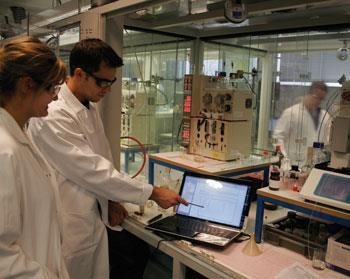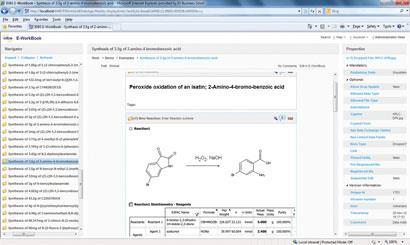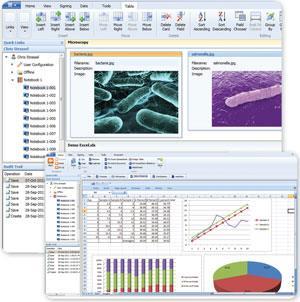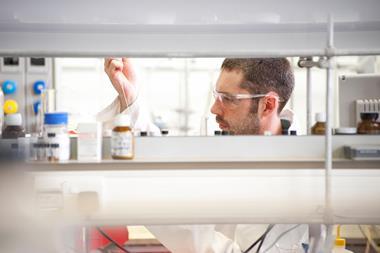With electronic lab notebooks finally making waves in academia, Anthony King asks whether the time has come to part company with the much loved paper lab book
With electronic lab notebooks finally making waves in academia, Anthony King asks whether the time has come to part company with the much loved paper lab book

The pharmaceutical industry was an early adopter of electronic lab notebooks (ELNs). The lab software packages offered them efficiency gains and ELNs are now firmly embedded among major pharma players. Agrichemical, fine chemical and petrochemical companies have jumped on board, and a new analyst report by the firm Global Industry Analysts forecasts that the annual market for ELNs will reach $284 million (?185 million) by 2017. Academic labs in universities have been slower to take up the technology, for reasons such as high costs and lack of infrastructure and IT support. But ELN providers are now moving to bridge this gap.
Industry perspective
’The early ELNs were developed predominantly around the workflows for medicinal chemistry. How can I take this molecular structure and prove that on a particular day I made that compound? That was driven by securing intellectual property,’ says Chris Molloy, vice president of corporate development at IDBS, one of the largest ELN providers, based in Guildford, UK. Two other big players in this field are CambridgeSoft (now part of PerkinElmer) and Accelrys.
ELNs are much more than a direct replacement for the traditional lab notebook, explains Molloy. The notebooks can integrate into a fully electronic lab environment, with information about how a sample is synthesised, the analytical result and any kind of conclusions brought together in a single place. ’Scientists open up their notebook and that’s where they start the day and that’s where they will finish the day. It drives everything they do,’ agrees Dominic John, product marketing director at Accelrys, headquartered in San Diego, US.
The efficient sharing of information often lost in paper lab notebooks is another reason for the ELN success story. ’The ELN describes who did what, why and when,’ says John. He gives the example of global healthcare giant Johnson & Johnson, which has deployed a single ELN across its process, formulation and analytical scientists. ’They will be doing a lot of ideation and exploration of the correct synthesis routes and tracking that in the ELN,’ he explains.
CambridgeSoft’s largest installation is at pharmaceutical firm Merck & Co, with 7000 users working off the same system, according to Michael Swartz, CambridgeSoft’s vice president of knowledge management. ’It’s used globally in every one of their R&D and manufacturing sites.’ ELNs allow you jump between levels of information, he says. ’Sometimes you need the data behind the summary.’

Data management in the pharmaceutical industry has become too complicated to rely on paper-based notes, agrees Tim Dickens, an ex-industrialist who now leads the IT team within the chemistry department of the University of Cambridge, UK. Dickens worked for the leading pharma firm GlaxoSmithKline for 24 years and says that one year after ELN rollout there, a survey of users found that over 80 per cent didn’t want to go back to paper lab books.
For contract research houses today, you are not competitive if you don’t have an ELN for recording your experiments, he says. ’You are seeing a lot of outsourcing of making molecules and using contract houses to perform assays and biological experiments,’ he observes, and ’it has become imperative to have electronic technology to capture the results of experiments.’
John says companies, such as Pfizer, who link in with academics for the purpose of doing research are starting to push for universities to install good IT infrastructure to help with communication flow and the protection of information in their labs. ’ELNs are a key driver for that,’ he says.
Academic labs
What about academia? Uptake has been rather poor, admits Dickens. A lot of academics have been very successful to date without ELNs and ’aren’t necessarily aware of how the world is changing and what this technology can do,’ he says. Apart from this inertia, many chemistry departments don’t have the money to set up and support this technology, unlike in the pharma industry where there is the cash and the payback is clear. At the Cambridge chemistry department only 20 out of the 600 researchers based there regularly use ELNs. Dickens is convinced it’s not a question of if but when: ’at some point in the future people will be surprised that we ever did chemistry without recording the results electronically’.

Cambridge’s tentative embrace of ELNs has been pioneered by organic chemistry professor Steve Ley. The old style notebook simply cannot be the best way to capture information, argues Ley, who has a strong record of collaboration with industry. He foresees enormous benefits in moving to ELNs.
’People tend to document reasonably well what works, but don’t tend to document so well what doesn’t work. If the data doesn’t find its way into a paper then it is almost certainly lost,’ says Dickens. ’It is bad enough trying to search someone’s thesis, but almost impossible to access and interpret somebody’s lab book.’
It’s useful for academics that may in future years have questions about data generated by a postdoc who has since moved on to another group or country, says IDBS’s Molloy. ’It is really important to be able to have that secure, permanent foundation of data that is ultimately dependable.’
Ley notes the safety benefits of being able to track chemicals in and out of a building and controlling chemical usage offered by ELNs. ’We don’t necessarily want PhD chemists to work with things that are likely to explode or use very expensive reagents without having a conversation with someone more senior,’ adds Dickens. He says there are benefits from supervisors being able to track what students are doing without having to stand over their shoulder. Mentoring and advice could one day be given to a student even when the principal investigator is at a conference and away from the lab.

Dickens also says that the use of ELNs in universities could be applied to a lot more areas of chemistry than it is being done at present. ’Classically it is done for small molecular work,’ he explains, ’but there is no reason it couldn’t be extended to other areas like theoretical chemistry.’
Breaking down barriers
Organic chemist Henry Rzepa of Imperial College London, UK, says there is a combination of reasons why university take-up of ELNs is ’slow and patchy’. They can require substantial infrastructure in IT, he says. And while computers are cheap to buy these days, the cost of running the infrastructure is not. Many chemistry departments don’t have a dedicated IT support function, Rzepa notes. Cambridge has an IT team, but Dickens acknowledges that even they struggle to provide a good level of application support.
’The idea that every chemistry department in the UK is going to set up its own infrastructure is a non-starter. I think it needs to be done at a regional, if not national, level, whereby you get multiple universities collaborating to run this infrastructure,’ says Dickens. But it’s not just shared servers, where the data is stored. ’I am also thinking about how you offer training and support, so that you start to get a cloud solution.’
And one UK funding body, the EPSRC (Engineering and Physical Sciences Research Council), is starting to consider this option. During a recent meeting of the EPSRC Dial-a-Molecule network - set up to promote research aimed at a step change in our ability to deliver molecules quickly and efficiently - it was recognised that the availability of chemical experiment data in an open, well-structured database would be a major enabler for future advances in chemistry, and that an ELN is the best way to collect this data. Barriers to ELN use in academia were also examined; the rarity of programming support and maintenance staff in the academic environment was discussed, and concerns about a lack of compatibility between ELN systems from different suppliers was noted.
In industry, the move into ELNs has been mostly top down. Senior management or IT take the decision that ELNs are a good idea. There may be some reluctance but staff will use the technology because it’s their job, explains Tim Aitken, product manager at IDBS. Universities have a heterogeneous environment, making it more difficult for them to enforce change.
But individual champions can be important drivers in universities. ’In academia, it does revolve around a professor pushing it or heads of departments realising that this is strategic for the department to embrace,’ says John of Accelrys. In Cambridge, Ley - who describes himself as not at all a ’techy’ person - fulfils this role.
’The biggest perception initially from academia was it was a big pharma tool,’ says John. ’This is not for little guys like us. We don’t have the infrastructure,’ he describes as standard responses. But John claims that now the cost of the products has come down and infrastructure needs are lower, both in terms of IT and admin, mainstream adoption has finally begun. John estimates that there are between 5000 and 10 000 users of ELNs in academia today.

Accelrys, CambridgeSoft and IDBS have all expressed a strong willingness to work with universities to provide the solutions they require. CambridgeSoft has recently worked with the University of Princeton and the University of Harvard in the US, and IDBS has a relationship with Ley’s group in Cambridge.
However, CambridgeSoft’s Swartz admits that cross compatibility, though on the wish list of universities, is not available right now. ’Like any IT system, it is sticky. You pick one and you live with it for a long time.’ CambridgeSoft, like the other providers, has academic pricing; Swartz says for a 20 person department $500 - $1000 per person would be a reasonable cost estimate.
The question is how we get the funding, says Dickens. ’We have to think carefully where we spend money today in universities on IT, and also think about the science research councils and the funding they provide and perhaps there should be better recognition that curating data and knowledge is very important. The ELN is an "information machine"; we have staff dedicated to running physical machines such as mass spectrometers, so why should an information machine be different?’
Another issue is ease of data access. The biggest demand from academia is transportability of data, explains Swartz. This is not really required by industry, who prefer to keep their information stored safely onsite. ’The academics want to take their data with them as they move. We have added functionality in the product to enable that,’ he says.
But Jeremy Frey, professor of physical chemistry at the University of Southampton, UK, views the commercial ELNs as still falling short of what is needed for sharing and collaborating in the academic landscape. He believes they have some ground to make up in terms of the whole paradigm toward publishing and providing links back to the lab notebook. ’Generally they don’t [currently] work for the academic mindset,’ he says. Frey himself is somewhat unusual. He is a physical chemist, whereas the majority of ELN users work on organic and inorganic chemistry, as he himself observes.
We’re all in this together
A national rollout of supported ELN technology for all universities is a very good idea, but it’s important that we get interoperability between notebooks, so that nobody is worried about the data being stuck somewhere and feel they are held hostage by a manufacturer, says organic chemist Richard Whitby from the University of Southampton.
’There should also be cost advantages, both in acquiring the software, but probably more importantly in the provision of support and training,’ he adds.
’It’s important that you can choose whatever style of notebook you want but you can communicate and share the information. I don’t see the national rollout as an adoption of one ELN.’ The data has to be exportable to other programs in a way that doesn’t lose formatting when used by another ELN, Whitby says.
The Dial-a-Molecule meeting looked at a possible national rollout and concluded that while ELN systems have progressed dramatically in recent years, making their products even more user-friendly would mean providers stood a good chance of their ELNs being adopted quickly in academia. ’They still need to sort the crucial problem of making the data easily transferable between various systems, since academia is inherently an open research environment with each research group in control,’ was a conclusion of a meeting summary document. Since universities and research groups are loosely coupled entities, the best ELN system should also be loosely bound. The Dial-a-Molecule group decided that it will promote a pilot programme for the adoption of ELN systems and has started recruiting volunteers for this scheme.
’I think some of the ELNs have got past the tipping point where the effort involved in implementing one [in universities] is outweighed by the efficiencies you gain,’ concludes Whitby.
Anthony King is a science writer based in Dublin, Ireland







No comments yet